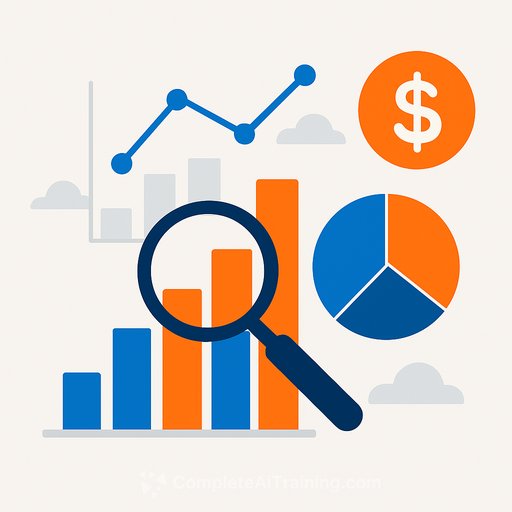AI Solutions for Financial Analysis and Auto Audit: Practical Tools, Use Cases, and How to Deploy
Finance teams are under pressure to close faster, reduce errors, and surface risks before they become findings. AI helps by automating data collection, spotting anomalies at scale, and generating audit-ready narratives and workpapers. The result: fewer manual loops, tighter controls, and decisions made with fresher data.
What AI Actually Does for Finance and Audit
- Automates grunt work: data extraction from PDFs and emails, account mapping, variance tagging, and tie-outs.
- Improves detection: flags unusual postings, duplicate vendors, out-of-period entries, and threshold breaches across full datasets.
- Speeds reporting: drafts MD&A-style narratives, audit memos, and SOX control summaries from your numbers and logs.
- Enables continuous monitoring: real-time alerts for exceptions, control drift, and KPI movements.
Where It Fits in Your Workflow
- Monthly/quarterly close: auto-reconcile, standardize roll-forwards, produce variance explanations, and route exceptions.
- SOX and internal audit: test populations instead of samples, document evidence chains, and maintain immutable audit trails.
- FP&A: consolidate from ERP/CRM, run scenarios, and answer ad-hoc questions with natural language prompts.
- ESG and regulatory reporting: standardize data collection and narrative generation with linked sources and lineage.
Notable Platforms and What They're Good For
Workiva - Cloud platform for regulatory reporting, SOX, ESG, audits, and financial reporting. Now includes generative AI for narrative drafting and control automation.
- Best for: Finance and audit teams that need connected reporting with strict governance and version control.
- Standout: Linked data, audit trails, and AI-assisted narratives that stay synchronized with source numbers.
MindBridge - Anomaly detection and risk assessment across full transaction populations to surface potential fraud, errors, and inefficiencies.
- Best for: External and internal audit teams seeking deeper coverage than sample-based testing.
- Standout: Risk scoring and pattern detection that highlight unusual entries and journal pathways.
Datarails - Excel-native FP&A platform for consolidation, forecasting, budgeting, and real-time reporting with an AI Q&A chat.
- Best for: Mid-market teams living in spreadsheets who want controls and automation without ditching Excel.
- Standout: Faster close and budget cycles, plus conversational queries over governed data.
Cube - FP&A tool that connects spreadsheets with ERP systems for continuous planning and scenario modeling, including natural language queries.
- Best for: Teams wanting spreadsheet flexibility with stronger data pipelines and versioning.
- Standout: Quick what-if analysis tied to source systems and controlled models.
SafeBooks - AI-driven automation and continuous financial monitoring to improve data transparency and reliability.
- Best for: Controllers seeking real-time exception alerts and ongoing controls visibility.
- Standout: Always-on checks for anomalies and policy breaches.
Implementation Checklist (Keep It Lean)
- Scope: Pick one process with clear pain: journal entry review, revenue recognition checks, or forecast variance analysis.
- Data readiness: Map systems, define owners, standardize COA, and clean key dimensions (entity, cost center, product).
- Access and governance: SSO, role-based access, segregation of duties, and immutable logs.
- Controls and validation: Build benchmark rules, thresholds, and back-tests. Document datasets, prompts, and changes.
- Change management: Train users, codify exception handling, define when to override AI outputs, and capture feedback.
KPIs That Prove ROI
- Close cycle time and manual hours saved per period
- Exception rate, false positive rate, and time-to-resolution
- Control deficiency rate and repeat findings
- Forecast accuracy and scenario turnaround time
Risk, Controls, and Documentation
Model governance matters. Document data lineage, model versions, prompts, test results, and override reasons. Maintain an audit trail for every automated step and decision.
- Use a formal framework for AI risk and controls, such as the NIST AI Risk Management Framework.
- Align audit analytics with regulator expectations. See PCAOB's perspective on data and technology in audits: Data and Technology in the Audit.
Quick Start Plan (4 Weeks)
- Week 1: Select one use case and assemble sample data. Define success metrics and approval flow.
- Week 2: Configure tool, connect ERP/GL, and validate outputs against last quarter's results.
- Week 3: Pilot with live data on a limited scope. Track exceptions and user feedback.
- Week 4: Tune rules/prompts, lock governance, and present KPI deltas. Plan phase two.
Choosing the Right Tool
- If reporting and SOX are your bottlenecks: Start with Workiva.
- If you need deeper audit coverage: Evaluate MindBridge.
- If FP&A speed and Excel control are the priority: Look at Datarails or Cube.
- If you want continuous monitoring and alerts: Consider SafeBooks.
Keep Learning and Building Capability
If you're mapping tools to finance use cases and want a curated view, this list can help: AI tools for finance. For role-based upskilling paths in finance and audit, see courses by job.
Start small, measure aggressively, document everything. The gains stack fast once data, controls, and people are aligned.
Your membership also unlocks:





